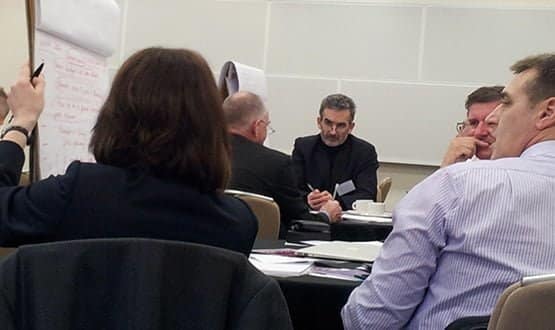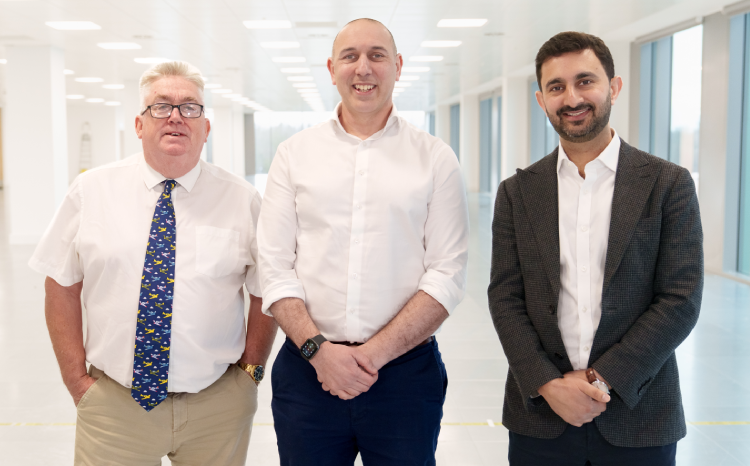Collaborative, working
- 17 February 2014

Delegates to the latest CCIO Leaders Network event were asked to take part in an unusual thought experiment – the “reverse brain storm.”
Since the theme of the King’s Fund event was collaboration, chair Dr Paul Shannon, the medical director of CSC, suggested it would be interesting to think about what non-collaboration would look like; and how it could be secured.
Dr Richard Griffiths, a specialist in lung, renal and acute oncology at Clatterbridge Cancer Centre NHS Foundation Trust, rose to the challenge, reading out a whole set of ideas that he and his table of fellow chief clinical information officers had come up with.
“One idea was that you do not appoint a CCIO,” he said. “Or you appoint somebody with no collaboration or communication skills; somebody who sits in an office and does not get out and meet people and find out what their needs are.”
Or, he added, an organisation might appoint somebody who did not go on to draw up a clinical strategy that could be kept under review, and linked to the strategic direction of their organisation. Or somebody who did not look outside their organisation at what was happening elsewhere.
Dr Shannon, who also works as a consultant anaesthetist at Doncaster and Bassetlaw NHS Foundation Trust, suggested that this would leave a CCIO stuck in their “comfort zone” and Dr Griffiths agreed.
“You only make decisions based on your own ideas,” he concurred, in reverse brain storm mode. “Or perhaps you make tactical decisions that seem to move people along, but which do not fit with the overall strategy.”
Work on yourself, work with colleagues
The thought experiment was prompted by a series of presentations from CCIOs who had braved bad weather and tube strikes to share their experiences of how to collaborate positively with colleagues, organisations and suppliers.
Chris Fokke, the CCIO of Hampshire Hospitals NHS Foundation Trust, which has an ambitious programme to create its own, portal-based electronic patient record, argued that it was important to take a step back, and start with “self.”
“As a CCIO, the pressure is unrelenting,” he said. “To cope with it you need capacity. It is important to think about coaching and reflective practice.”
Fokke said he turned to online coaching modules when he needed to brush up on particular skills, or find a way around a knotty problem, and he is also a fan of mentoring and networking. Within his trust, he said, he also used formal engagement as a means of collaboration.
“Every fortnight, I meet junior doctors and talk about the major issues they are aware of,” he said. “You get a lot of ‘on a bank holiday, what really makes my life hell is…’ that is really important, and which you can feedback into development phases and priorities.”
Similarly, Dr Colin Brown, the CCIO of University Hospitals of Morecambe Bay NHS Foundation Trust, which went live with a ‘first of type’ Lorenzo electronic patient record in 2010, stressed the need to be “visible.”
“Clinical engagement is about hearts and minds, hearts and minds, hearts and minds – and good communications,” he said.
.
Dr Brown also argued that “quick wins” were vital for building confidence – as long as they did build towards an overall goal.
For example, he said the trust had moved quickly to create structured discharge letters for GPs, to replace the scribbled “rubbish” that it used to send them; and that it is now sending 4,000 communications a month. Reciprocally, hospital doctors can now see summary information from GPs’ Emis systems within the Lorenzo EPR.
Take a strategic view, think how to work with suppliers
Dr Hashim Reza, the CCIO of Oxleas NHS Foundation Trust, which has gone from generating spreadsheets of performance data for its staff to creating dashboards for them that are widely shared across the organisation, argued that structures also mattered.
The in-house developers of the iFOx [information For Oxleas] project, who initially sat within IT and finance, were now part of a business intelligence and performance directorate that has the same weight as the trust’s clinical directorates, he said; underling how information has become core to the functioning of the organisation.
In response to questions from the other CCIOs present, Dr Reza also mused on the role of compulsion in rolling out and then completing projects; and in moving from paper to electronic working.
He said Oxleas had decided that the paper record would no longer be a patient’s primary legal record once an electronic record was in place; and upheld this in serious incident reviews. “Any clinician who keeps notes on paper is taking a risk professionally,” he said, adding that Oxleas conducts “monthly audits” of practice and has now “started shredding.”
Most organisations are liable to take a long time to get this far, however. Dr Brown said that Morecambe had started by using Lorenzo for patient administration, clinical documentation, results reporting, digital image viewing and discharge planning.
As of last year, it rolled the system out to accident and emergency and maternity, and it is now introducing ‘paper-lite’ working in outpatients, with a view to extending this to inpatients.
This, he said in response to another question, had prompted a change in the trust’s collaboration with its supplier, CSC, which had more than 100 people on site for the initial go-live, but which is now looking to work with a user group.
Brown, who chairs the group, argued this was a positive development, taken alongside the creation of a roadmap for the further development of Lorenzo.
“We had ten trusts at the user group a couple of months ago, and their needs were broadly similar, except for those running community services, which we don’t do,” he said. “That maps to experience around the world, where needs are similar and are converging.”
Sometimes, leadership is the answer
Dr Cormac Breen, the CCIO of Guy’s and St Thomas’ NHS Foundation Trust, took a different approach to the issue of collaboration between NHS organisations and IT suppliers.
He weighed up the pros and cons of insourcing – or developing a system in-house – and outsourcing – or buying and then deploying a product from an external supplier. Or, rather, he weighed up when one was likely to be more appropriate than another.
Dr Breenargued that outsourcing, in the sense that he used the word, was more likely to be appropriate when good products exist, and the parameters within which they should be deployed are well understood; citing, as an example, e-prescribing, for which his trust is using MedChart.
He argued that insourcing was more useful where “you want to change or standardise business processes”; citing as an example handover, for which lots of different systems exist – from paper notes to e-documents to app-based systems – and for which his trust is undertaking its own development, which will be built into a portal.
For this development, he stressed, “technology has been the last bit of the project.” Getting agreement on what needs to be recorded, how it should be consistently presented, and how it should be built into new workflows, has been far more important.
This was reflected in the second half of the feedback session, which took a more traditional “brain storming” approach to what good collaboration would look like.
Delegates talked about working for a common aim, about bringing professional skills to the table but being willing to make compromises to achieve that aim, about setting out good strategies and, again, about the need to be visible and to constantly communicate that aim.
But sometimes, Johan Waktare, the CCIO of Liverpool Heart and Chest Hospital NHS Foundation Trust and an EHI columnist, argued there is a need to “step aside from collaboration and to take a leadership role.”
Dr Shannon agreed. Collaboration may be key to a CCIO’s success. But “there are times when you have to be strategic to get things to move.”




